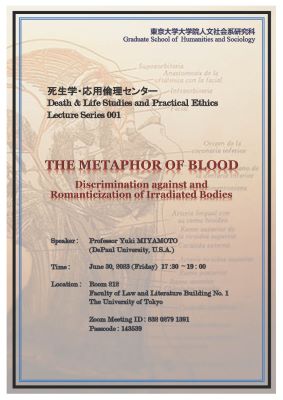THE METAPHOR OF BLOOD
Discrimination against and Romanticization of Irradiated Bodies

【日時】2023年6月30日(金)17:30-19:00
【会場】 東京大学本郷キャンパス 文学部法文1号館212教室
【オンライン会場】Zoom Meeting ID : 832 0279 1391 Passcode : 143539
【参加について】参加無料・事前予約不要
【使用言語】英語(通訳なし)
【主催】東京大学大学院人文社会系研究科 死生学・応用倫理センター
【助成】布施学術基金
※この講演会は布施学術基金により助成を受けています。
講師紹介 Speaker : Professor Yuki MIYAMOTO(DePaul University, U.S.A.)
Professor Miyamoto earned her Ph.D. in ethics from the Divinity School at the University of Chicago. Her monographs are Beyond the Mushroom Cloud: Commemoration, Religion, and Responsibility after Hiroshima in 2011, A World Otherwise: Environmental Praxis in Minamata in 2021 and Naze Genbaku ga Akudeha Nainoka [Japanese] from Iwanami in 2020. Her most recent work is a translation of The Hanford Plaintiffs: Voices from the Fight for Atomic Justice into Japanese, Mokusatsu sareta hibakusha no koe: Amerika Hanfōdo seigi o motomete tatakatta genkoku tachi from Akashi shoten in 2023. Today's talk is entitled as "The Metaphor of Blood: Discrimination against and Romanticization of Irradiated Bodies."
Abstract
Discrimination against hibakusha—those who witnessed and suffered the effects of the atomic bombings of 1945—has been little studied in Anglophone academia, while in Japan, although the issue has been discussed anecdotally, it has not yet been situated within the discourse of discrimination in general. This paper, in describing the discrimination directed against the hibakusha, focuses on the metaphor of blood that has been used to discriminate against other underrepresented groups in Japan, such as the buraku people (outcastes), and argues that this discrimination was reinforced by the Meiji ideology, which emphasizes the imperial family’s “unbroken lineage”—the fiction of purity of blood. I claim that this metaphor was extended and applied to hibakusha after 1945. However, at the same time, in the popular media, descriptions of the hibakusha’s bodies and illnesses (often blood diseases) have also been romanticized. Thus, centering on Susan Sontag’s Illness as Metaphor and employing theories from feminist/gender/queer studies and disability studies, I illustrate the construction of body norms with the metaphor of blood while drawing upon a variety of sources, including historical documents, oral histories, literature, and pop culture, to demonstrate how the metaphor of blood has been used to exclude hibakusha in Japanese society.